#St. Martin's Parish
Photo
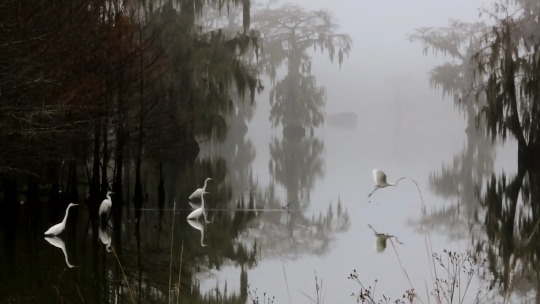
Foggy Morning Great White Egrets
Lake Martin, St. Martin Parish, Louisiana
Photographer: Betty Bérard (Mon Reve)
#betty berard (mon reve)#photographer#foggy morning#great white egrets#egrets#lake martin#st martin parish#louisiana#nature#bird photography
28 notes
·
View notes
Text
St Martin Parish Church - #ThursdayDoors
Matthäus Günther painted scenes from the life of St Martin on six panels on the Bohemian style cupolas which are organised around double traverse arches and double pilasters.
I have more than just door photos this week. The interior of St Martin Parish Church in Garmisch-Partenkirchen is too beautiful not to share. I walked through it with my mouth open when I visited a few weeks ago.
I’d better credit Stephen for this photo! He fancies himself as a spectacular photographer! (I might just go ahead and hire him! 🙃)
And I have a little history to tell as well.
Early…

View On WordPress
0 notes
Photo

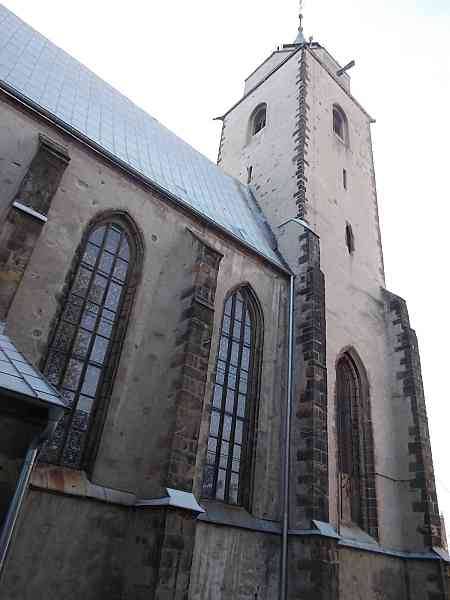
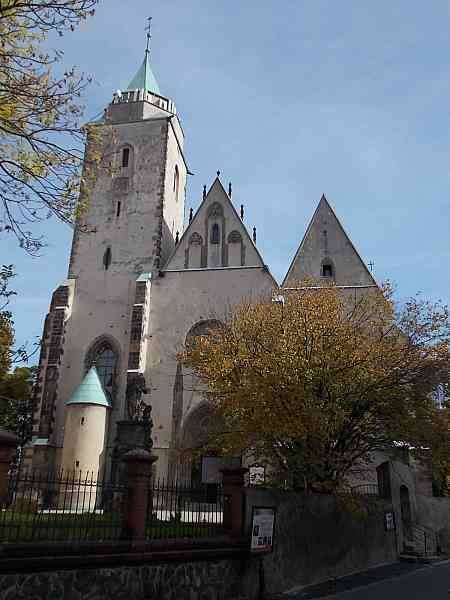
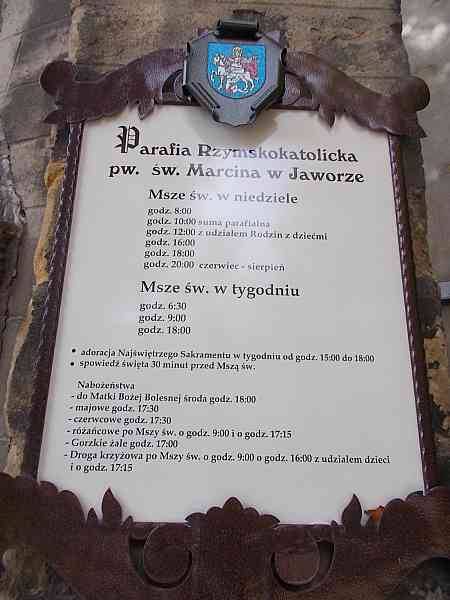
St. Martin’s church in Jawor, Lower Silesia, Poland.
#sw. Marcina#St. Martin's#church#kościół#parafia#parish#Dolny Śląsk#Dolny Slask#Lower Silesia#Jawor#Polen#Polska#Poland#Polonaise#Polonia
1 note
·
View note
Link
Shaping safe, confident, and responsible drivers in the greater Oakdale and Lafayette areas for more than 30 years.
Take our comprehensive teen or adult driver ed course at our driving school in Lafayette or Oakdale. Gain confidence behind-the-wheel and learn the rules of the road with our Louisianna state-approved driver ed program.
Our Louisiana-certified driver ed program teaches fundamentals of vehicle operation and the rules of the road in a safe and fun environment. Complete all your driver ed classroom, behind-the-wheel instruction, and DMV road test at A Freeman Defensive Driving School.
MANDATORY: All parents and students must come in prior to class starting to sign paperwork and bring in the original copy of the student's birth certificate and Temporary Permit Card (TIP). You must obtain a TIP from the OMV. Learn [email protected]
#teen class#st martin parish#lafayette parish#iberia parish#education#driving school#allan parish#acadia parish#6 hour#38 hour#14 hour#k12 academics
0 notes
Text
While most Ukrainians battled against Germany during the war, it’s well known that the western region of the country collaborated with the Third Reich — and that thousands of those involved were allowed to resettle in Canada. [...]
When Anthony Rota, [...] introduced Hunka during Zelenskyy’s Sept. 22 visit, he called him a “veteran from the Second World War who fought for Ukrainian independence against the Russians and continues to support the troops today.”
And Hunka made the argument himself after Russia invaded his homeland last year. “In the last war, I joined the Ukrainian underground to fight Russia, so I was fighting the same people they’re fighting now,” he told a reporter covering a peace vigil in North Bay, Ontario, in March 2022.
“Nothing has changed there. The same enemy. First Stalin was there and now this idiot,” he said, referring to Russian President Vladimir Putin. [...]
In a post for the SS Galichina veterans’ blog Combatant News, Hunka wrote that 1941 to 1943 — after Germany invaded Ukraine and before Hunka enlisted — were the happiest years of his life. He also recalled eagerly awaiting “the legendary German knights” to come and attack “the hated Poles,” using a slur for Polish people, in 1939.
Captioned photos from the blog show Hunka during SS artillery training in Munich in December 1943 and in Poland around the time of a visit by Nazi mastermind Heinrich Himmler. “I know that if I ordered you to liquidate the Poles … I would be giving you permission to do what you are eager to do anyway,” Himmler said during that visit, according to several historical accounts.
Now, the Polish minister of education is looking into whether Hunka can be extradited and prosecuted for what happened during the war.[...]
[After the war,] Hunka made his living in the aircraft industry, working his way up to inspector at DeHavilland Aircraft in Toronto. After retirement, he visited Ukraine nearly every year, according to a profile of him in a University of Alberta newsletter announcing the donation made in his honor by his sons. The profile said he also served as president of the parish council of St. Volodymyr Ukrainian Catholic Church in Thornhill, Ontario.[...]
In his mea culpa, Rota made it sound like Hunka was a constituent from his district [...] whom he did not know much about. “This initiative was entirely my own,“ Rota said[...]
But Rejean Venne, an independent Canadian journalist, wrote in his Substack newsletter this week that Rota and Hunka family members have had numerous chances to cross paths over the years. Among Venne’s examples:
- One of Hunka’s sons, Martin, was chief financial officer of Redpath Mining, a multinational corporation headquartered in Rota’s district. Redpath has contributed to Rota’s campaigns and Rota has provided government funding for recreational facilities operated by Redpath. (The company did not respond to inquiries from the Forward made Thursday.)
- Martin Hunka has also served as chair of the board of trustees for North Bay Hospital, which is located in Rota’s district and which Rota has supported. Hunka’s name can no longer be found on the hospital’s website and social media posts. (The hospital did not respond to a request for comment emailed Thursday.)
- North Bay Pride, an LGBTQ+ organization, gave an award to Rota nine months after Yaroslav’s granddaughter Leshya Lecappelain joined its board of directors. In 2022 and 2023, North Bay Pride received more than $100,000 in funding from Rota. (Asked about this, a spokesperson for North Bay Pride said Lecappelain had not been on its board for several years.)
“Rota’s response that this was a last-minute request doesn’t add up,” Venne said in an email interview. “The Hunka family appears well connected in Rota’s district.”
The Forward could not determine whether Hunka and Rota met before he was honored at Parliament. Rota and others at the House of Commons did not respond to several requests for comment sent Wednesday and Thursday.
Efforts to reach Yaroslav, Martin and Peter Hunka, Lecappelain and other members of the family for comment were also unsuccessful.[...]
On Wednesday, the University of Alberta said it would return the CA$30,000 endowment that Hunka’s sons donated in 2019 in their father’s honor. The money was intended to fund research at the school’s Canadian Institute for Ukrainian Studies.
But Per Anders Rudling, a university alumnus and expert on Ukrainian nationalism who teaches at Sweden’s Lund University, said the Hunka fund is just “the top of an iceberg.”
In an email to the Forward, Rudling said the University of Alberta has “much larger endowments” honoring other figures connected to the Waffen SS unit. The “most problematic,” he said, is the Volodymyr and Daria Kubijovych Memorial Endowment Fund [Editors note: archive link - also "matched two-to-one by the Government of Alberta"] At CA$450,000 — about $334,000 — it’s 15 times larger than the Hunka fund the university is returning.[...]
In a Facebook post Thursday, Rudling also questioned university endowments named for other Galichina Division veterans, including Roman Kolisnyk, Levko Babij and Edward Brodacky.
Pointing to research he published in The Journal of Slavic Military Studies [Editors note: 1, 2], Rudling said, “I have tried to raise this issue in the past, to no avail.”
Asked about Rudling’s concerns, Michael Brown, a spokesperson for the University of Alberta, reiterated a statement in which interim provost Verna Yiu said the school is “reviewing its general naming policies and procedures, including those for endowments, to ensure alignment with our values.” Yiu also expressed the school’s “commitment to address anti-Semitism in any of its manifestations, including the ways in which the Holocaust continues to resonate in the present.”
The honors given to SS Galichina fighters extend beyond academia. One of the University of Alberta’s endowments is for its former chancellor Peter Savaryn, another SS Galichina member. In 1987, Savaryn was awarded the Order of Canada, among the nation’s highest honors, bestowed by Canada’s governor general, the representative of the British Crown. Mary Simon, the current governor general, has condemned the Hunka scandal as “a shock and an embarrassment.”[...]
When the Hunka endowment was announced in 2020, the university said it would fund research on two “leaders of the underground Ukrainian Catholic Church,” Cardinal Josyf Slipyj and Metropolitan Andrei Sheptytsky. (A metropolitan is akin to a bishop.)
Slipyi was a deputy in Ukraine’s 1941 self-proclaimed government, which pledged to work closely with Germany under Hitler’s leadership. Slipyi also assigned chaplains to SS Galichina and celebrated the unit’s inaugural Mass. After the war, the Soviets sent him to gulag prison camps.
But Sheptytsky’s legacy is layered [sic]. He helped “dozens of Jews find refuge in his monasteries and even in his own home,” according to Yad Vashem, while also supporting “the German army as the savior of the Ukrainians from the Soviets.”
Harvard University also houses a Ukrainian Research Institute. Asked, after Alberta’s announcement, whether that institute’s funding would be scrutinized for Nazi ties, the university said in a statement that the institute had never received money from the Hunkas, nor had it received donations designated for research related to SS Galichina.
Harvard did, however, in 1974 establish a fellowship and faculty position in European studies with money from a foundation named for Alfred Krupp, who was convicted of war crimes for using slave laborers from Auschwitz to build and work in a factory.[...]
In Canada, questions about the Ukrainian immigrants’ past dogged them for decades, and in 1985, the country launched a Commission of Inquiry on War Criminals, known as the Deschênes Commission.
Investigators were mostly limited to considering evidence gathered in Canada, and ultimately they came to the controversial conclusion that the Galichina Division “should not be indicted as a group” and that “mere membership” in the division was insufficient to justify prosecution or revoke citizenship.
This week, as Trudeau apologized for the Hunka salute, B’nai Brith Canada called for the full release of the commission’s report, which had been heavily redacted, along with other Holocaust-era records, in order to “restore public trust in our institutions.”
“Canadians deserve to know the full extent to which Nazi war criminals were permitted to settle in this country after the war,” the group said Tuesday[...]
Why would Hunka’s family risk his humiliation, at age 98, by putting him under a spotlight? Did they not realize how his military record would be perceived and portrayed?
“It’s arrogance. It’s not naiveté,” said Jack Porter, a research associate at Harvard’s Davis Center for Russian and Eurasian Studies and himself a Jewish child survivor of the Holocaust, born in Ukraine.
“They know what their father did,” he said. “It’s hubris, it’s chutzpah. They rationalize that these men were fighting communism. If a few Jews were killed, they also were communists.”[...]
More than 2.5 million Ukrainians died fighting against Germany. “There were many good Ukrainians; they should not all be stigmatized,” he said.
But he said veterans who fought under the Nazis like Hunka and his compatriots have been emboldened by the whitewashing of their history, especially since Russia’s invasion of Ukraine last year.
“They’ve been hiding in plain sight,” he said. “They’ve been there for 60 years and nobody has touched them, so of course they feel OK.”
29 Sep 23
144 notes
·
View notes
Text
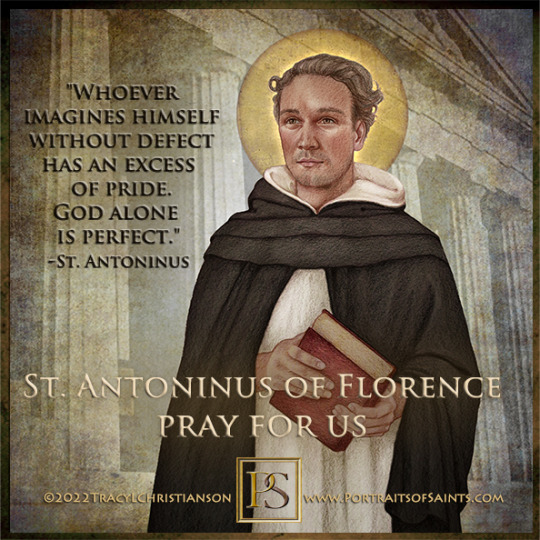
Saint Antoninus of Florence
1389-1459
Feast Day: May 2
Patronage: Moncalio, Turin, Italy, University of Santo Tomas Graduate School, Malia, Philippines, Pura Tarlac, Philippines, St. Antoninus Parish
Saint Antoninus was born to a noble family in Florence. He was a pious youth and a good friend of St. Dominic. At the young age of 16 he became a Dominican. Eventually he became the prior of St. Marks and reluctantly, Bishop of Florence. In this capacity, he was a reformer, theologian, confessor, and spiritual director and established a lay society known as “Good Men of St. Martin” which gave assistance to the poor. He died among his Dominican brothers on the feast of the Ascension.
Prints, plaques & holy cards available for purchase here: (website)
22 notes
·
View notes
Text
As Reformation Day Approaches...
Many will wish to talk about Martin Luther. Which makes sense because he famously nailed the 95 theses to the church door at Wittenburg on October 31st.
But what better time to commemorate all of the OTHER important figures and reformers of the Protestant reformation? Of whom there were many.
Wikipedia lists 284 people burned in England under Queen Mary I, as she attempted to consolidate her power. Her new laws declared anyone teaching against Catholic doctrines to be guilty of heresy and subject to the death penalty. The Catholic church has never denounced these murders committed by its members on its behalf.
These laws affected famous and regular people alike. Over time I may make a series of posts with more detail about some of these persons.
Incomplete list of the protestant martyrs in England under the cut. Courtesy of Wikipedia.
Protestants executed under Mary I
1. John Rogers City of London clergyman – preacher, biblical translator, lecturer at St. Paul's Cathedral burnt 4 February 1555 Smithfield, London
2. Lawrence Saunders City of London clergyman – preacher, Rector of All Hallows Bread Street, London burnt 8 February 1555 Coventry, Warwickshire
3. John Hooper Gloucester and Worcester clergyman – Bishop of Gloucester and Worcester under Edward VI burnt 9 February 1555 Gloucester, Gloucestershire
4. Rowland Taylor Hadleigh, Suffolk clergyman – Rector of Hadleigh, Suffolk burnt 9 February 1555 Aldham Common, Nr Hadleigh, Suffolk[5]: p.98 [59]
5. Rawlins White Cardiff, Glamorgan fisherman burnt March 1555 Cardiff, Glamorgan[60]
6. Thomas Tomkins Shoreditch, London weaver burnt 16 March 1555 Smithfield, London[61]
7. Thomas Causton Horndon on the Hill or Thundersby, Essex gentleman burnt 26 March 1555 Rayleigh, Essex[62]
8. Thomas Higbed Horndon on the Hill or Thundersby, Essex gentleman burnt 26 March 1555 Horndon-on-the-Hill, Essex[62]
9. William Hunter Coleman Street Parish, London apprentice burnt 27 March 1555 (or 26 according to Foxe) Brentwood, Essex
10. Stephen Knight barber burnt 28 March 1555 Maldon, Essex[64]
11. William Pygot (or Pigot) butcher burnt 28 March 1555 Braintree, Essex[64]
12. [n 6] William Dighel burnt 28 March 1555 Banbury, Oxfordshire [65][66]
13. John Lawrence (or Laurence) clergyman – priest and former Blackfriar at Sudbury, Suffolk[50] burnt 29 March 1555 Colchester, Essex[64]
14. Robert Ferrar St David's, Pembrokeshire clergyman – Bishop of St David's under Edward VI burnt 30 March 1555 Carmarthen, Carmarthenshire[67]
15. George Marsh Dean, Lancashire clergyman – curate to Laurence Saunders and minister at Dean, Lancashire burnt 24 April 1555 Boughton, Cheshire[68]
16. William Flower Lambeth, London surgeon and teacher burnt 24 April 1555 Westminster[69]
17. John Cardmaker Wells, Somerset clergyman – prebendary of Wells Cathedral burnt 30 May 1555 Smithfield, London[70]
18. John Warne Walbrook, London upholsterer burnt 30 May 1555 Smithfield, London[70]
19. Thomas Hawkes (or Haukes) Essex gentleman burnt 10 June 1555 Coggeshall, Essex
20. Thomas Watts (or Wattes) Billericay, Essex linen draper burnt 10 June 1555 Chelmsford, Essex[7][72]
21. John Ardeley (or Ardite) Wigborough, Essex husbandman burnt 30 May 1555 (or 'about 10 June', according to Foxe) Rayleigh, Essex[7][73]
22. John Simson Wigborough, Essex husbandman burnt 30 May 1555 (or 'about 10 June', according to Foxe) Rochford, Essex[7][73]
23. Nicholas Chamberlain (or Chamberlaine) Coggeshall, Essex weaver burnt 14 June 1555 Colchester, Essex[7][74]
24. William Bamford (or Butler)[n 8]Coggeshall, Essex weaver burnt 15 June 1555 Harwich, Essex[7][74]
25. Thomas Ormond (or Osmande)[n 9]Coggeshall, Essex fuller burnt 15 June 1555 Manningtree, Essex[7][74]
26. John Bradford City of London clergyman – prebendary of St Paul's Cathedral burnt 1 July 1555 Smithfield, London[7][75][76]
27. John Leaf (or Jhon Least) Christ Church Greyfriars, London (born in Kirkby Moorside, Yorkshire) apprentice tallow chandler burnt 1 July 1555 Smithfield, London
Canterbury Martyrs of July 1555
28. John Bland (or Blande) Rolvenden, Kent clergyman – vicar of Rolvenden, Kent burnt 12 July 1555 Canterbury, Kent [7][78]
29. Nicholas Shetterden (or Shitterdun) burnt 12 July 1555 Canterbury, Kent
30. John Frankesh Adisham, Kent clergyman – parson of Adisham, Kent burnt 12 July 1555 Canterbury, Kent
31. Humphrey Middleton Ashford, Kent burnt 12 July 1555 Canterbury, Kent
32. Nicholas Hall Dartford, Kent bricklayer burnt 19 July 1555 Rochester, Kent
33. Christopher Wade Dartford, Kent linen-weaver burnt July 1555 Dartford, Kent
34. Margaret (or Margery) Polley Pepeling, Calais widow burnt 17 July 1555 Royal Tunbridge Wells, Kent[80]
35. Dirick Carver (also spelt Deryk; also known as Dirick Harman) Brighthelmstone (now Brighton), Sussex beer-brewer burnt 22 July 1555, Lewes, East Sussex
36. John Launder Godstone, Surrey husbandman burnt 23 July 1555 Steyning, West Sussex
37. Thomas Euerson (or Iueson, Iverson or Iveson) Godstone, Surrey carpenter burnt (day unknown) July 1555 Chichester, West Sussex
38. Richard Hook (or Hooke) lame man [66] burnt unknown date in July 1555 Chichester, West Sussex
39. James Abbess Stoke-by-Nayland, Suffolk shoemaker burnt 2 August 1555 Thetford, Norfolk (or Bury, according to Foxe)
40. John Denley Maidstone, Kent gentleman burnt 8 August 1555 Uxbridge, Middlesex
41. Robert Smith Windsor, Berkshire clerk at the college in Windsor, Berkshire and painter burnt 8 August 1555 Uxbridge, Middlesex
Canterbury Martyrs of August 1555
42. William Coker burnt 23 August 1555 Canterbury, Kent [7][89]
43. William Hopper Cranbrook, Kent[79] burnt 23 August 1555 Canterbury, Kent [7][89]
44. Henry Laurence burnt 23 August 1555 Canterbury, Kent [7][89]
45. Richard Collier (or Colliar) burnt 23 August 1555 Canterbury, Kent
46. Richard Wright Ashford, Kent[79] burnt 23 August 1555 Canterbury, Kent
47. William StereAshford, Kent[79] burnt 23 August 1555 Canterbury, Kent
48. Elizabeth Warne (or Warren)[n 13]Walbrook, London widow of John Warne, upholsterer burnt 23 August 1555 Stratford-atte-Bow, London
49. Roger Hues (aliases: Curryer, Corier) St Mary's, Taunton, Somerset burnt 24 August 1555 Taunton, Somerset [66][7][91]
50. George Tankerfield London (born in York) cook burnt 26 August 1555 St Albans
51. Patrick Pakingham (aliases: Packingham, Pachingham, Patchingham or Pattenham) burnt 28 August 1555 Uxbridge, Middlesex [7][87]
52. John Newman Maidstone, Kent pewterer burnt 31 August 1555 Saffron Walden, Essex [7][87]
53. Robert Samuel (or Samuell) Barfold, Suffolk clergyman – minister at Barfold, Suffolk burnt 31 August 1555 Thetford, Norfolk[7][93]
54. Stephen HarwoodWare, Hertfordshire brewer burnt 30 August 1555 Stratford in Essex[7][94]
55. Thomas Fust (or Fusse) hosier, August 1555 In the environs of London or Ware
56. William Hale (or Hailes)Thorpe, Essex, late August 1555 In the environs of Barnet, London
57. William Allen Somerton, Norfolk labourer burnt early September 1555 Walsingham, Norfolk
58. Roger Coe (or Coo or Cooe) Melford, Suffolk shearman burnt date unknown September 1555 Yoxford, Suffolk
59. Thomas CobHaverhill, Suffolk butcher burnt date unknown September 1555 Thetford, Norfolk
Canterbury Martyrs of September 1555
60. George Catmer (or Painter) Hythe, Kent burnt about 6 September 1555, according to Foxe (or 12 July 1555) Canterbury, Kent
61. Robert Streater (or Streter) Hythe, Kent burnt about 6 September 1555, according to Foxe (or 12 July 1555) Canterbury, Kent
62. Anthony Burward Calete (possibly Calais) [98] burnt about 6 September 1555, according to Foxe (or 12 July 1555) Canterbury, Kent
63. George Brodbridge (or Bradbridge) Bromfield, Kent burnt about 6 September 1555, according to Foxe (or 12 July 1555) Canterbury, Kent
64. James Tutty (or Tuttey)Brenchley, Kent burnt about 6 September 1555, according to Foxe (or 12 July 1555) Canterbury, Kent
65. Robert Glover (or Glouer)Mancetter, Warwickshire gentleman burnt 14 September 1555 Coventry, Warwickshire
66. Cornelius Bongey (or Bungey) capper burnt 20 September 1555 Coventry, Warwickshire
67. Thomas Hayward (or Heywarde) burnt mid September 1555 Lichfield, Staffordshire
68. John Goreway Holy Trinity Parish, Coventry, Warwickshire [50] burnt mid-September 1555 Lichfield, Staffordshire Ely Martyrs
69. William WolseyUpwell, Norfolk constable, one of the Ely Martyrs burnt 16 October 1555 Cathedral Green, Ely, Cambridgeshire
70. Robert Pygot (or Pigot) Wisbech, Isle of Ely, Cambridgeshire painter, also an Ely Martyr burnt 16 October 1555 Cathedral Green, Ely, Cambridgeshire
Oxford Martyrs
71. Hugh Latimer (or Latymer) Baxterley, Warwickshire [103] clergyman – chaplain to King Edward VI burnt 16 October 1555 outside Balliol College, Oxford
72. Nicholas RidleyFulham Palace clergyman – Bishop of London under Edward VI burnt 16 October 1555 outside Balliol College, Oxford
Canterbury Martyrs of November 1555
73. John Webbe (or Web) gentleman burnt 30 November 1555 Canterbury, Kent [7][105]
74. George Roper burnt 30 November 1555 Canterbury, Kent [7][105]
75. Gregory Parke (or Paynter)[citation needed] burnt 30 November 1555 Canterbury, Kent [7][105]
76. John PhilpotWinchester, Hampshire clergyman – Archdeacon of Winchester burnt 18 December 1555 Smithfield, London[7][106]
77. Thomas Whittle (or Whitwell)Essex clergyman – priest or minister burnt 27 January 1556 Smithfield, London[7][107]
78. Bartlett (or Bartholomew) GreenTemple, London – born in Basinghall, London gentleman and lawyer burnt 27 January 1556 Smithfield, London[7][107]
79. Thomas BrownSt Bride's parish, Fleet Street, London – born in Histon, Cambridgeshire burnt 27 January 1556 Smithfield, London[7][107]
80. John TudsonSt Mary Botolph parish, London – born in Ipswich, Suffolk artificer burnt 27 January 1556 Smithfield, London[7][107]
81. John Went (or Winter or Hunt) Langham, Essex artificer burnt 27 January 1556 Smithfield, London[7][107]
82. Isobella Forster (or Annis Foster) St Bride's parish, Fleet Street, London – Born in Greystoke, Cumberland wife of John Foster, cutler burnt 27 January 1556 Smithfield, London[7][107]
83. Joan Lushford (or Jone Lashforde, or Warne) Little Allhallows parish, Thames Street, London maid burnt 27 January 1556 Smithfield, London
Canterbury Martyrs of 1556
84. John Lomas (or Jhon Lowmas) Tenterden, Kent burnt 31 January 1556 Wincheap, Canterbury [7][108]
85. Annes Snoth (or Annis Snod) Smarden, Kent widow burnt 31 January 1556 Wincheap, Canterbury [7][108]
86. Anne Wright (or Albright); alias Champnes burnt 31 January 1556 Wincheap,Canterbury [7][108]
87. Joan (or Jone) SoaleHorton, Kent wife burnt 31 January 1556 Wincheap, Canterbury [7][108]
88. Joan Catmer Hythe, Kent 'wife (as it should seem) of George Catmer', burnt in 1555 burnt 31 January 1556 Wincheap, Canterbury [108][n 15][7]Ipswich Martyrs of 1556
89. Agnes Potten Ipswich, Suffolk wife of Robert Potten burnt 19 February 1556 Ipswich, Cornhill [7][n 16][109]
90. Joan Trunchfield Ipswich, Suffolk wife of Michael Trunchfield, a shoemaker burnt 19 February 1556 Ipswich, Cornhill
91. Thomas Cranmer Lambeth Palace clergyman – Archbishop of Canterbury (former) burnt 21 March 1556 outside Balliol College, Oxford[7][110]
92. John Maundrel Beckhampton, Wiltshire – brought up in Rowde, Wiltshire husbandman burnt 24 March 1556 outside Salisbury, Wiltshire
93. William Coberly Wiltshire tailor burnt 24 March 1556 outside Salisbury, Wiltshire
94. John Spicer (or Spencer) Winston, Suffolk[50] freemason or bricklayer burnt 24 March 1556 outside Salisbury, Wiltshire
95. John Harpole (or Hartpoole) St Nicholas Parish, Rochester, Kent burnt 1 April 1556 Rochester, Kent[7][112]
96. Joan BeachTunbridge Wells, Kent widow burnt 1 April 1556 Rochester, Kent
97. John Hullier (or Hulliarde) Babraham, Cambridgeshire clergyman – curate of Babraham, Cambridgeshire burnt 16 April 1556 Cambridge, Cambridgeshire
98. William Tyms (or Timmes)Hockley, Essex clergyman – curate of Hockley, Essex burnt 24 April 1556 Smithfield, London
99. Robert DrakeThundersley, Essex clergyman – minister or parson of Thundersley, Essex burnt 24 April 1556 Smithfield, London
100. Richard SpurgeBocking, Essex shearman burnt 24 April 1556 Smithfield, London[7][115]
101. Thomas SpurgeBocking, Essex fuller burnt 24 April 1556 Smithfield, London[7][115]
102. George AmbroseBocking, Essex fuller burnt 24 April 1556 Smithfield, London[7][115] 103. John Cavel (or Cauell)Bocking, Essex weaver burnt 24 April 1556 Smithfield, London[7][115]Colchester martyrs of April 1556
104. Christopher ListerDagenham, Essex husbandman burnt 28 April 1556 Colchester, Essex [7][116]
105. John MaceColchester, Essex apothecary burnt 28 April 1556 Colchester, Essex [7][116]
106. John SpencerColchester, Essex weaver burnt 28 April 1556 Colchester, Essex [7][116]
107. Simon Joyne sawyer burnt 28 April 1556 Colchester, Essex [116]
108. Richard NicolColchester, Essex weaver burnt 28 April 1556 Colchester, Essex
109. John HamondColchester, Essex tanner burnt 28 April 1556 Colchester, Essex [7][116]
110. Hugh Laverock (or Lauarocke) Barking, Essex painter, (a lame man) burnt 15 May 1556 Stratford in Essex
111. John Apprice (or Aprice) blind man burnt 15 May 1556 Stratford-Atte-Bow or Stratford in Essex
112. Thomas Drowry blind boy burnt about 15 May 1556 Gloucester, Gloucestershire [7][n 18][118]
113. Thomas Croker bricklayer burnt about 15 May 1556 Gloucester, Gloucestershire [7][n 18][118]
114. Katherine HutBocking, Essex widow burnt 16 May 1556 Smithfield, London[7][117]
115. Elizabeth ThackvelGreat Burstead, Essex maid burnt 16 May 1556 Smithfield, London[7][117]
116. Joan (or Jone) HornsBillericay, Essex maid burnt 16 May 1556 Smithfield, London
117. Thomas Spicer Winston, Suffolk labourer burnt 21 May 1556 Beccles, Suffolk
118. John Deny (or Denny) (possibly a female Joan or Jone) Beccles, Suffolk burnt 21 May 1556 Beccles, Suffolk
119. Edmund PooleBeccles, Suffolk burnt 21 May 1556 Beccles, Suffolk
120. Thomas HarlandWoodmancote, Sussex carpenter burnt 6 June 1556 Lewes, Sussex
121. John Oswald (or Oseward) Woodmancote, Sussex husbandman burnt 6 June 1556 Lewes, Sussex
122. Thomas Reed Ardingly, Sussex burnt about 6 June 1556 Lewes, Sussex
123. Thomas Avington (or Euington) Ardingly, Sussex turner burnt about 6 June 1556 Lewes, Sussex
124. Adam Forster (or Foster) Mendlesham, Suffolk husbandman burnt 17 June 1556 Bury St Edmunds, Suffolk [124][125]
125. Robert Lawson Mendlesham, Suffolk linen weaver burnt 17 June 1556 Bury St Edmunds, Suffolk [124][125]
126. Thomas Wood clergyman – pastor burnt about 20 June 1556 Lewes, Sussex
127. Thomas Milles Hellingly, Sussex burnt about 20 June 1556 Lewes, Sussex
128. Thomas Moor servant and husbandman burnt 26 June 1556 Leicester, Leicestershire
Stratford Martyrs, 11 men and 2 women.
129. Henry Adlington (or Addlinton) Grinstead, Sussex sawyer burnt about 27 June 1556 Stratford-Atte-Bow[7][126]
130. Lawrence (or Laurence) ParnamHoddesdon, Hertfordshire smith burnt about 27 June 1556 Stratford-Atte-Bow[7][126]
131. Henry WyeStanford-le-Hope, Essex brewer burnt about 27 June 1556 Stratford-Atte-Bow[7][126]
132. William Holywell (or Hallywell)Waltham Holy Cross, Essex, smith. burnt about 27 June 1556 Stratford-Atte-Bow
133. Thomas Bowyer (or Bowier)Great Dunmow, Essex weaver burnt about 27 June 1556 Stratford-Atte-Bow
134. George Searle White Notley, Essex tailor burnt about 27 June 1556 Stratford-Atte-Bow
135. Edmond Hurst St James's Parish, Colchester labourer burnt about 27 June 1556 Stratford-Atte-Bow[7][126]
136. Lion/Lyon Cawch City of London merchant/broker burnt about 27 June 1556 Stratford-Atte-Bow[7][126]
137. Ralph Jackson Chipping Ongar, Essex, serving-man burnt about 27 June 1556 Stratford-Atte-Bow[7][126]
138. John Derifall (or Dorifall) Rettendon, Essex labourer burnt about 27 June 1556 Stratford-Atte-Bow[7][126]
139. John Routh/Roth Wickes, Essex labourer burnt about 27 June 1556 Stratford-Atte-Bow
140. Elizabeth Pepper St James's parish, Colchester wife of Thomas Pepper, weaver burnt about 27 June 1556 Stratford-Atte-Bow
141. Agnes George West Barefold, Essex wife of Richard George, husbandman burnt about 27 June 1556 Stratford-Atte-Bow
142. Roger Bernard Framsden, Suffolk labourer burnt 30 June 1556 Bury St Edmunds, Suffolk [124][125]
143. Julins Palmer Reading, Berkshire schoolmaster burnt about 15 July 1556 'The Sand-pits', Nr Newbury, Berkshire
144. John Guin/Jhon Gwin shoemaker [66] burnt about 15 July 1556 'The Sand-pits', Nr Newbury, Berkshire[7][128]
145. Thomas Askin/Askue burnt about 15 July 1556 'The Sand-pits', Nr Newbury, Berkshire
Guernsey Martyrs – (Three women and one unborn male foetus)
146. Catherine Cauchés (sometimes spelt Katherine Cawches) St Peter Port, Guernsey, Channel Islands burnt 18 July 1556 St Peter Port, Guernsey, Channel Islands[129]
147. Perotine Massey (pregnant) St Peter Port, Guernsey, Channel Islands wife of NormanCalvinist minister burnt 18 July 1556 St Peter Port, Guernsey, Channel Islands[129]
148. Guillemine GilbertSt Peter Port, Guernsey, Channel Islands burnt 18 July 1556 St Peter Port, Guernsey, Channel Islands
149. Thomas Dungate (or Dougate) East Grinstead, Sussex burnt 18 July 1556 Grinstead, Sussex
150. John Forman (or Foreman) East Grinstead, Sussex burnt 18 July 1556 Grinstead, Sussex
151. Anne Tree (or Try) West Hoathly, Sussex burnt 18 July 1556 Grinstead, Sussex
152. Joan WasteAll Hallows', Derby, Derbyshire blind woman burnt 1 August 1556 Derby, Derbyshire
153. Edward Sharp glover (possibly)[66] burnt early September 1556 Bristol, Gloucestershire/Somerset
154. Rose Pencell burnt 17 October 1555 Bristol
155. William Shapton weaver burnt 17 October 1555 Bristol[131]
156. John Kurde Syresham, Northamptonshire shoemaker burnt October 1556 or 20 September 1557 Northampton, Northamptonshire
157. John Noyes Laxfield, Suffolk shoemaker burnt 22 September 1556 or 1557 [133]
158. Thomas Ravensdale burnt 24 September 1556 Mayfield, Sussex[85][122]
159. John Hart burnt 24 September 1556 Mayfield, Sussex [85][122]
160. Unknown man shoemaker burnt 24 September 1556 Mayfield, Sussex [85]
161. Unknown man currier burnt 24 September 1556 Mayfield, Sussex [85]
162. Nicholas Holden Withyham, Sussex weaver burnt 24 September 1556 Mayfield, Sussex
163. Unknown man carpenter burnt 25 September 1556 Bristol, Gloucestershire/Somerset
164. John Horn burnt late September 1556 Wotton-under-Edge, Gloucestershire
165. John Phillpott Tenterden, Kent burnt 16 January 1557 Wye, Ashford, Kent
166. Thomas Stephens Biddenden, Kent burnt 16 January 1557 Wye, Ashford, Kent
Canterbury Martyrs of January 1557
167. Stephen KempeNorgate, Kent burnt 15 January 1557 Canterbury, Kent [136]
168. William WatererBiddenden, Kent burnt 15 January 1557 Canterbury, Kent [136]
169. William ProwtingThurnham, Kent burnt 15 January 1557 Canterbury, Kent [136]
170. William LowickCranbrook, Kent burnt 15 January 1557 Canterbury, Kent [136]
171. Thomas HudsonSelling, Kent burnt 15 January 1557 Canterbury, Kent [136]
172. William HayHythe, Kent burnt 15 January 1557 Canterbury, Kent [136]
173. Nicholas Final Tenterden, Kent burnt 16 January 1557 Ashford, Kent
174. Martin Bradbridge Tenterden, Kent burnt 16 January 1557 Ashford, Kent
175. William Carman (or Carmen)[n 28] burnt day and month unknown 1557 [138]
176. Thomas Loseby burnt 12 April 1557 Smithfield, London
177. Henry Ramsey burnt 12 April 1557 Smithfield, London
178. Thomas Thyrtell (or Sturtle) burnt 12 April 1557 Smithfield, London
179. Margaret Hyde burnt 12 April 1557 Smithfield, London
180. Agnes Stanley (or Stanlye) burnt 12 April 1557 Smithfield, London
181. Richard Sharpe weaver burnt 7 May 1557 Cotham, Bristol[141]
182. Thomas Hale shoemaker burnt 7 May 1557 Cotham, Bristol[141]
183. Stephen Gratwick (or Steuen Grathwick) Brighthelmstone (now Brighton), Sussex burnt at end of May 1557 St. George's Fields, Southwark, Surrey
184. William Morant burnt at end of May 1557 St. George's Fields, Southwark, Surrey [7][142]: p. 272 [143]
185. Thomas King[66] burnt at end of May 1557 St. George's Fields, Southwark, Surrey
Maidstone martyrs
186. Joan (or Jone) Bradbridge Staplehurst, Kent Presumably a relative of Widow Bradbridge, burnt 19 June 1557[144] burnt 18 June 1557 Maidstone, Kent [7][145]
187. Walter Appleby Maidstone, Kent burnt 18 June 1557 Maidstone, Kent [7][145]
188. Petronil Appleby Maidstone, Kent wife of Walter Appleby burnt 18 June 1557 Maidstone, Kent [7][145]
189. Edmund Allin (or Allen) Maplehurst Mill, Frittenden, Kent miller burnt 18 June 1557 Maidstone, Kent [7][145]
190. Katherine Allin (or Allen) Maplehurst Mill, Frittenden, Kent Wife of Edmund Allin/Allen, miller burnt 18 June 1557 Maidstone, Kent [7][145]
191. Joan (or Jone) Manning Maidstone, Kent burnt 18 June 1557 Maidstone, Kent [7][145]
192. Elizabeth (surname possibly 'Lewis') blind maid burnt 18 June 1557 Maidstone, Kent [7][145]Canterbury martyrs of June 1557
193. John Fishcock/Jhon Fiscoke burnt 19 June 1557 Canterbury, Kent [7][145]
194. Nicholas White burnt 19 June 1557 Canterbury, Kent [7][145] 195. Nicholas Pardue/Perdue burnt 19 June 1557 Canterbury, Kent [7][145]
196. Barbara Final burnt 19 June 1557 Canterbury, Kent [7][145]
197. Bradbridge's Widow (Bradbridge's Wife) Probably Tenterden, Kent Probably the widow of Martin Bradbridge, burnt 16 January 1557 burnt 19 June 1557 Canterbury, Kent [145]
198. Mistress Wilson (also referred to as 'Wilson's Wife') burnt 19 June 1557 Canterbury, Kent [7][145]
199. Alice Benden, possibly also referred to as 'Benson's Wife' Staplehurst (or possibly Cranbrook), Kent[146] burnt 19 June 1557 Canterbury, Kent
Lewes Martyrs
200. Richard WoodmanWarbleton, Sussex iron-maker burnt 22 June 1557 Lewes, Sussex [7][82][147]
201. George Stevens (or Steuens) Warbleton, Sussex burnt 22 June 1557 Lewes, Sussex
202. William MainardMayfield, Sussex burnt 22 June 1557 Lewes, Sussex
203. Alexander HosmanMayfield, Sussex servant of William Mainard burnt 22 June 1557 Lewes, Sussex
204. Thomasina WoodMayfield, Sussex maidservant of William Mainard burnt 22 June 1557 Lewes, Sussex
205. Margery Morris (or Morice) Heathfield, Sussex burnt 22 June 1557 Lewes, Sussex
206. James Morris (or Morice) – son of Margery Heathfield, Sussex burnt 22 June 1557 Lewes, Sussex
207. Denis Burcis (or Burgis) Buxted, Sussex burnt 22 June 1557 Lewes, Sussex
208. Ann Ashdon (or Ashdown; also referred to as 'Ashdon's Wife') Rotherfield, Sussex burnt 22 June 1557 Lewes, Sussex
209. Mary Groves (also referred to as 'Gloue's Wife') Lewes, Sussex burnt 22 June 1557 Lewes, Sussex
210. Simon Miller (or Milner) Lynn, Norfolk burnt 13 July 1557 Norwich, Norfolk
211. Elizabeth Cooper St Andrew's Church, Norwich, Norfolk wife of a pewterer burnt 13 July 1557 Norwich, Norfolk [7](which calls her 'a woman')
212. George Egles/Eagles hung, drawn & quartered, August 1557 Chelmsford, Essex[7][150]Colchester Martyrs of August 1557
213. William BongeorSt Nicholas Parish, Colchester, Essex glazier burnt 2 August 1557 Colchester, Essex [151]
214. William Purchase (or Purcas) Bocking, Essex fuller burnt 2 August 1557 Colchester, Essex [151]
215. Thomas Benhote (or Benold) Colchester, Essex tallow-chandler burnt 2 August 1557 Colchester, Essex
216. Agnes Silverside (or Smith) Colchester, Essex widow burnt 2 August 1557 Colchester, Essex [151]
217. Helen (or Ellen) EwringColchester, Essex wife of John Ewring, miller burnt 2 August 1557 Colchester, Essex [151]
218. Elizabeth Folk Colchester, Essex 'young maiden' and servant burnt 2 August 1557 Colchester, Essex [151]
219. William Munt (or Mount)Much Bentley, Essex burnt 2 August 1557 Colchester, Essex
220. Alice Munt (or Mount) Much Bentley, Essex wife of William Munt (or Mount) burnt 2 August 1557 Colchester, Essex [151]
221. Rose Allen (or Allin) Much Bentley, Essex spinster, daughter of Alice Mount burnt 2 August 1557 Colchester, Essex [151]
222. John JohnsonThorpe, Essex labourer burnt 2 August 1557 Colchester, Essex [151]
223. Richard Crashfield Wymondham, Norfolk burnt 5 August 1557 Norwich, Norfolk[7] which records 'one at Norwich' in July[152]
224. Father Fruier burnt August 1557 Rochester, Kent[7][150]
225. Robert Stevenson burnt August 1557 Rochester, Kent[153]
226. Sister of George Eagles burnt August 1557 Rochester, Kent
227. Unknown Woman burnt August 1557 Rochester, Kent[7]
228. Agnes Prest Boyton, Cornwall Spinner burnt 15 August 1557 Southernhay, Exeter [154]
229. Thomas Benion weaver burnt 27 August 1557 Bristol[141]
230. Joyce Lewis Mancetter, Warwickshire gentlewoman burnt September 1557 Lichfield, Staffordshire – may be the same as Joyce Bowes, August 1557 (the Regester)
231. Ralph Allerton/Rafe Glaiton Much Bentley, Essex burnt 17 September 1557 Islington
232. James Austoo (or Auscoo) burnt 17 September 1557 Islington
233. Margery Austoo (or Auscoo) burnt 17 September 1557 Islington[7][157]
234. Richard Roth (or Rooth) burnt 17 September 1557 Islington
235. Agnes Bongeor (also known as Bowmer's Wife), wife of Richard Bongeor (similar name but different death date) burnt 17 September (or unknown date July) Colchester, Essex (or March 1558, Colchester)
236. Margaret Thurston/Widow Thurston-similar name but different death date burnt 17 September (or unknown date July) Colchester, Essex [132](or March 1558, Colchester)
237. Cicely Ormes St Edmund's Parish, Norwich, Norfolk wife of Edmund Ormes, worsted-weaver burnt 23 September 1557 Norwich, Norfolk
238. Thomas Spurdance servant of the Queen burnt November 1557 Bury St Edmunds, Suffolk
239. John Halingdale/Hallingdale/Hollingday carpenter burnt, 18 November/or day unknown October 1557, Smithfield, London
240. William Sparrow burnt, 18 November/or day unknown October 1557 Smithfield, London
241. Richard Gibson gentleman[66] burnt, 18 November/or day unknown October 1557 Smithfield, London
242. John Rough/Jhon Roughe London/Islington, Middlesex clergyman – minister at London/Islington, Middlesex burnt 22 December 1557 Smithfield, London
243. Margaret Maring (or Mering) burnt 22 December 1557 Smithfield, London
244. [Unknown forename ...] Lawton burnt March 1558 Huntingdon, Huntingdonshire
245. Cuthbert Symson/Symion London/Islington, Middlesex clergyman – deacon of the church in London/Islington, Middlesex died 28 March 1558 Smithfield, London
246. Hugh Foxe hosier[66] died 28 March 1558 Smithfield, London
247. John Devinish/Jhon Denneshe wool winder, died 28 March 1558 Smithfield, London
248. William Nichol burnt 9 April 1558 SM9515 Haverfordwest/Hwlffordd, Pembrokeshire/Sir Benfro
249. William Seaman (or Symon) Mendlesham, Suffolk husbandman burnt 19 May 1558 Norwich, Norfolk
250. Thomas Hudson Aylsham, Norfolk glover burnt 19 May 1558 Norwich, Norfolk[166] described as 'Glouer' in [7]
251. Thomas Carman[n 28] burnt 19 May 1558 Norwich, Norfolk
252. William Harris burnt 26 May 1558 Colchester[7][127]
253. Richard Day burnt 26 May 1558 Colchester, Essex [7][127]
254. Christian George (female) burnt 26 May 1558 Colchester, Essex her husband had previously been married to Agnes George, mentioned above
Islington Martyrs
255. Henry Pond (or Houde) burnt 27 June 1558 Smithfield, London
256. Reinald Eastland (or Launder) burnt 27 June 1558 Smithfield, London
257. Robert Southain (or Southam) burnt 27 June 1558 Smithfield, London
258. Matthew Ricarby (or Ricarbie) burnt 27 June 1558 Smithfield, London
259. John Floyd (or Flood) burnt 27 June 1558 Smithfield, London
260. John Holiday (or Hollyday) burnt 27 June 1558 Smithfield, London
261. Roger Holland London (taken in or near St John's Wood) merchant tailor burnt 27 June 1558 Smithfield, London
262. Sir Richard Yeoman (or Yeman) Hadleigh, Suffolk clergyman – curate of Hadleigh, Suffolk burnt 10 July 1558 Norwich, Norfolk
Islington Martyrs (second group)
263. Robert Mills burnt 14 July 1558 Brentford, Middlesex [167]
264. Stephen Cotton burnt 14 July 1558 Brentford, Middlesex
265. Robert Dynes burnt 14 July 1558 Brentford, Middlesex [167]
266. Stephen Wight (or Wreight) burnt 14 July 1558 Brentford, Middlesex
267. John Slade burnt 14 July 1558 Brentford, Middlesex
268. William Pikes (aliases: Pikas, Peckes) tanner burnt 14 July 1558 Brentford, Middlesex [7][167]
269. John Cooke sawyer burnt about 25 July 1558 Bury St Edmunds, Suffolk [170]
270. Robert Milles (or Plummer) shearman burnt about 25 July 1558 Bury St Edmunds
271. Alexander Lane wheelwright burnt about 25 July 1558 Bury St Edmunds, Suffolk
272. James Ashley bachelor burnt about 25 July 1558 Bury St Edmunds, Suffolk
273. Thomas Benbrike/Benbridge gentleman burnt unknown day in July 1558 Winchester, Hampshire
274. John (or Richard) Snell Bedale, Yorkshire burnt 9 September 1558 Richmond, Yorkshire
Ipswich Martyrs of 1558
275. Alexander Gooch (or Geche, or Gouch) Woodbridge or Melton, Suffolk weaver of shredding-coverlets burnt 4 November 1558 Ipswich Cornhill
276. Alice DriverGrundisburgh, Suffolk wife of a husbandman burnt 4 November 1558 Ipswich Cornhill [173]
277. Philip Humphrey (or Humfrey) burnt November 1558 Bury St Edmunds, Suffolk
278. John David/Jhon Dauy (brother of Henry David) burnt November 1558 Bury St Edmunds, Suffolk
279. Henry David/H. Dauy (brother of John David) burnt November 1558 Bury St Edmunds, Suffolk [174]Canterbury Martyrs of 1558
280. John CornefordWrotham, Kent burnt 15 November 1558 Canterbury, Kent [175]
281. Christopher Brown Maidstone, Kent burnt 15 November 1558 Canterbury[175]
282. John HerstAshford, Kent burnt 15 November 1558 Canterbury, Kent
283. Alice Snoth burnt 15 November 1558 Canterbury, Kent [175]
284. Katherine Knight/Tynley an aged woman burnt 15 November 1558 Canterbury
#english reformation#history#protestant#now you will see me open up about my study of the english reformation#protestant martyrs
62 notes
·
View notes
Photo

Lake Bled Sunset Twilight, Slovenia
Colorful Sunset over Lake Bled. Beautiful view over famous Lake Bled with St. Martin’s Parish Church and Bled Castle on Clifftop together with the Lake Waterfront Promenade. Lake Bled Hill Range reflecting in the tranquil lake water. Lake Bled, Slovenia, Central Europe
#Bled#Bled Castle#bledersee#bledlake#Castle#church#Dramatic#Dramatic Sky#dusk#Europe#getty#getty images#istock#Julian Alps#Lake#Lake Bled#lakebled#lakebledslovenia#Landschaft#mlenny#mlenny photography#Natur#photography#Promenade#scenics#Slovenia#St. Martin's Parish#St. Martin's Parish Church#sunset#Top
60 notes
·
View notes
Text



─ •✧ WILLIAM'S YEAR IN REVIEW : DECEMBER ✧• ─
4 DECEMBER - William wrote the Foreword for 'Two Million Shout conversations: Saving lives at scale through the power of technology'.
5 DECEMBER - The Prince of Wales joined Dave Martin in selling the Big Issue Magazine at Tesco in Hammersmith. Afterwards, he joined Catherine at the annual Diplomatic Corps Reception.
6 DECEMBER - The Waleses were spotted Christmas Tree Shopping at Windsor Great Park.
7 DECEMBER - The Prince of Wales attended a Royal Foundation Meeting at the offices in London. Afterwards, William visited Emma Webb on Day-13 of 'Leg on to London’ Mental Health fundraising and awareness campaign in memory of her daughter - Brodie. He also appeared in a video message to ICAP for ICAP Charity Day.
8 DECEMBER - William along with Catherine and their children attended the Christmas Carol Service in Westminster Abbey.
9 DECEMBER - The Wales Family's Christmas Card was released.
11 DECEMBER - William chaired a Meeting of The Prince's Council at Buckingham Palace. Afterwards he visited The Passage Charity's St. Vincent's Centre for a Pre-Christmas Lunch.
12 DECEMBER - William visited the Warrant Officers' and Senior Non-Commissioned Officers' Mess at Combermere Barracks.
14 DECEMBER - The Prince of Wales was received by His Majesty's Lord-Lieutenant of Devon (Mr. David Fursdon) as he attended the Lord High Admiral's Divisions at Britannia Royal Naval College.
18 DECEMBER - William presented condolences to The Emir of the State of Kuwait in Kuwait, following the death of The Emir Nawaf Al-Ahmad Al-Jaber Al-Sabah.
24 DECEMBER - 'Together At Christmas' Carol Service aired on ITV with a special reading by William.
25 DECEMBER - A personal tweet from Will & Cat was released wishing everyone a merry christmas. Later, they along with their children joined other members of the Royal Family for the Divine Service at Sandringham Parish Church. The Waleses appeared in a video during the King's Christmas Address.
26 DECEMBER - William appeared in 'Charles III : A Coronation Year'.
29 DECEMBER - An 'Year In Review' video was released by Kensington Palace.
30 DECEMBER - Matt Porteus released a new photograph of the Waleses attending the Coronation Concert in May.
#catherine review : december#review 2023#year in review : 2023#review december#year in review : william#year in review 2023 : william#british royal family#british royals#royalty#royals#brf#kate middleton#british royalty#royal#prince of wales#the prince of wales#prince william#william prince of wales#princess of wales#the princess of wales#princess catherine#catherine princess of wales#prince george#duchess of cambridge#prince louis#princess charlotte#royaltyedit#royalty edit#my edit#my photoset
21 notes
·
View notes
Note
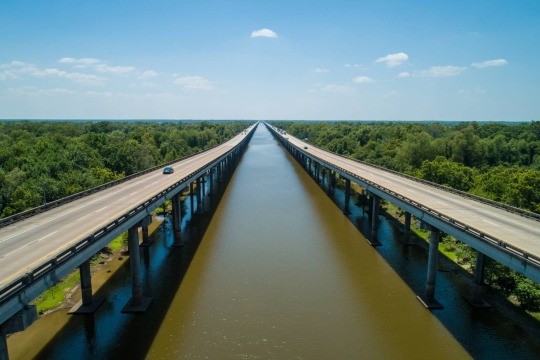
Atchafalaya Basin Bridge - Iberville Parish and St. Martin, Louisiana, USA
16 notes
·
View notes
Text
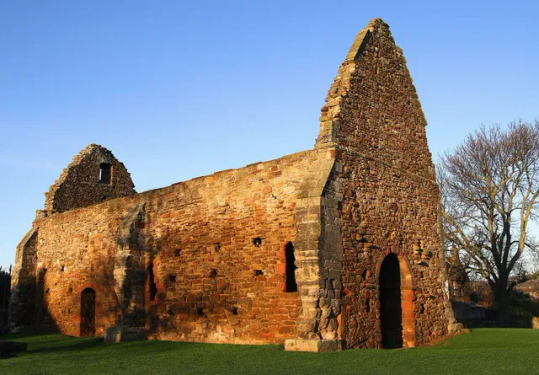
July 4th used to be called St Martin of Bullion’s Day, the verse goes…..
Bullion’s Day, gif ye be fair, For forty days ‘twill rain nae mair.
In Scotland, this used to be called St Martin of Bullion’s Day, and the weather which prevailed upon it was supposed to have a prophetic character. It was a proverb, that if the deer rise dry and lie down dry on Bullion’s Day, it was a sign there would be a good gose-harvest – gose being a term for the latter end of summer; hence gose-harvest was an early harvest. It was believed generally over Europe that rain on this day betokened wet weather for the twenty ensuing days.
St. Martin’s day was known on Donside as “Martin Bulg’s Day”; in the Buchan district of Aberdeenshire it is called “Marcabillin’s Day”.
The day is in honour of the translation of the saint’s body to a shrine in the cathedral of Tours and probably came over to Scotland when the Normans arrived.
There are traces of both Martin and Bullion in Scottish topography. In Perthshire there is the parish of St. Martin’s, containing the estate of St. Martin’s Abbey. Some miles to the east is Strathmartin in Forfarshire and not far from it in the same county we find Bullionfield, in the parish of Liff and Benvie. It is probable that these names are in some way connected together.
In most respects, St Martin of Bullion’s Day, is very much like St. Swithun’s Day, which is only 8 days away.
The pic shows the ruins of St. Martin’s Kirk in Haddington.
38 notes
·
View notes
Photo

Spider & Web
St. Martin Parish, Louisiana
Photographer: Betty Bérard (Mon Reve)
20 notes
·
View notes
Text
Feast Days: Martinmas
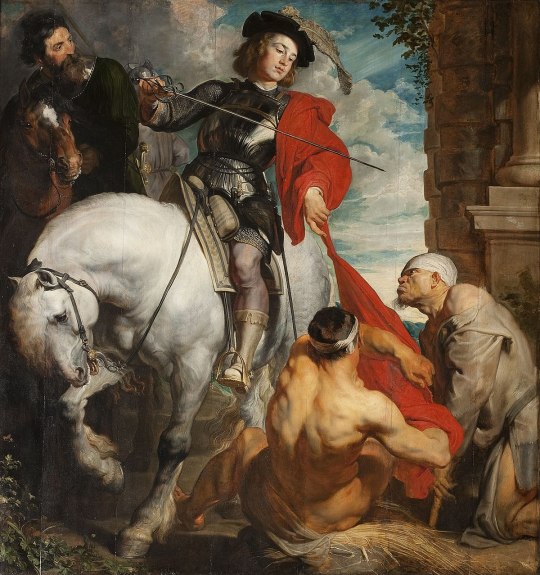
Anthony Van Dyck ~ "St. Martin Dividing His Cloak" (c.1618)
Happy Martinmas!
Today marks the feast day of St. Martin of Tours, who was bishop there from 371 CE until his death in 397 CE. He is the patron saint of many things, including: against poverty, against alcoholism, the poor, cavalry, Buenos Aires, quartermasters, wool-weavers, soldiers, and tailors, as well as wine growers, makers, and sellers. Whew! He must be very busy.
Keep reading for info about his life, a snitch goose, where the word 'chapel' came from, and how to tell what the weather will be like at Christmas.
His Life
Much of what we know about Martin comes from his hagiographer, Sulpicius Severus, who includes some 'artistic license' that is common in chronicles of the time, and therefore must be taken with a grain of salt.
Martin was born anywhere from 316-336 CE in Savaria, now Szombathely, Hungary. His father was a senior officer in the Roman Army, and as such was given land in northern Italy for his retirement. At the age of 10, Martin attended a Christian church against the wishes of his parents, and became interested in Christianity. Because of his father's status as a veteran, he was required to join the cavalry at 15. Dates surrounding his military service are shaky, but Severus states that, during his time stationed in Gaul, he was riding on horseback when he encountered a poor man with threadbare clothes. Having compassion on him, Martin used his sword to cut his own woolen cloak in two and gave the other half to the man. That night, Jesus Christ appeared to him in a dream, surrounded with angels and wearing half of the cloak. After this, Martin was baptised as a Christian. Though other miracles of his are recorded, this tale is the one most associated with Martin's life. It fits in with depictions of God or his angels in disguise as a beggar, traveller, &c., and is also a narrative found in many other religions and traditions. (Biblical examples include Abraham feeding the three angels in Genesis 18).
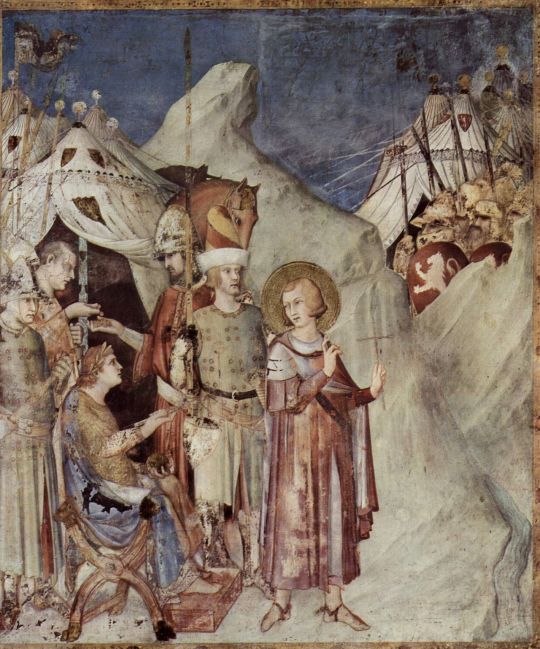
Martin dips from the army ~ fresco by Simone Martini (c.1320s)
With his new faith now firmly a part of his life, Martin decided to leave the army. Before a battle near modern-day Worms, Germany, Martin went before Emperor Julian and refused his salary, saying, "I am the soldier of Christ: it is not lawful for me to fight." They threw him in prison for this, but due to ye olde extenuating circumstances, he was released and discharged without further incident.
Martin made his way to modern-day Tours in France and declared himself a hermit, becoming a disciple and friend of Hilary of Tours. Because Christianity was Not OK™ in the Roman Empire, he and Hilary faced a lot of discrimination, including corporal punishment and exile. After converting his mother to Christianity and having numerous adventures, like living pretty much alone on an island, he and Hilary settled down in and around Poitiers, where Martin established Ligugé Abbey. It is the oldest known monastery in Europe! Martin made it his home base while he preached throughout western Gaul.

In 371 CE, the bishop of Tours died, and Martin was considered a good candidate for a successor. However, he liked living as a hermit and monk, and they resorted to tricking him into coming to Tours and then forced him to become the bishop. Legend holds that he tried to hide in a barn, but a honking goose gave him away. Hence he is the patron saint of geese, which I think is adorable. Martin proved true to his hermit ways, living very simply in huts with his monks. He established a rudimentary parish system, through which he visited different Christian communities and established monasteries. He was very determined in his efforts to convert local Pagans, as well as protect Christian institutions from unfriendly sects in the area, and in some cases he was successful. He died in 371 CE, already a venerated man. His popularity was ensured by his adoption by various French royals and by the Third Republic as a national symbol.
Martin has been portrayed by several famous artists, including Van Dyck, Peter Bruegel the Elder, and El Greco. He is usually portrayed on horseback, dividing his cloak for the poor man, though occasionally he can be seen riding a donkey. This references another story in his life about the time where he met the Devil and outwitted him. It also connects him to the image of Jesus riding a donkey into Jerusalem (recounted in Mark 1:1-11).
Martinmas and its Traditions
Martin lent his legacy to a host of English words and phrases, including those relating to the word 'chapel'. Temporary buildings that held the relic of his cloak (cappa in Latin) were referred to as cappella, and hence the word 'chapel' was born. A similar thing happened to the word 'chaplain', which derived from the word for the priest in charge of the cloak.
Though the Anglo-Saxon church did celebrate St. Martin to some extent, more references to Martinmas celebrations begin to crop up after Norman Conquest of 1066, when the Frenchman William the Conqueror invaded England. Supposedly, he promised to build an abbey dedicated to Martin if his invasion of England was successful. William was very likely familiar with the early Mediaeval association of the battle-hungry rulers of France with St. Martin, and was possibly responsible for his increased popularity in England.
In England and Scotland, and indeed through much of western Europe, Martinmas became a celebration marking the culmination of the harvest and the beginning of winter. From the late fourth century through the late Middle Ages, it also served a similar purpose to Mardi Gras/Carnivale: a period of fasting was ordained for the day after Martinmas through Christmas, so Martinmas was your last chance to stuff your face for a long time! (This period later became Advent, though with much laxer rules). As such, it was a time for feasting, celebration, bonfires, getting really drunk, and even events such as bull-running, as in Stamford, Lincolnshire. It was also a time for the end-of-harvest tasks, such as sowing winter wheat and slaughtering pigs and cattle. An old English saying goes, "His Martinmas will come, as it does to every hog", meaning, "they will get their comeuppance" or "everyone dies someday". Due to Martin's association with geese, some celebrated with a roast goose, but in Britain particularly it was also popular to eat salted pork or beef. For those not rich enough to have a goose, a duck or hen would also suffice. Other traditional fare included black pudding, haggis, and the first wine of the season.
On the business side of things, Martinmas served as a quarter day in Scotland and in parts England. A quarter day was one of four days on which major legal business was conducted. Servants and labourers would be hired or let go, rent was paid, contracts would begin or end, &c. Hiring fairs would be held for agricultural labourers seeking employment, and there would also be entertainment, food, trading, and other scenes of merriment. One of the most famous Martinmas fairs was at Nottingham in England, which lasted eight days.
Like many other English holidays, there is weather folklore associated with Martinmas. To have a warm fall and winter is to have a "St. Martin's Summer". If Martinmas proves an icy day, Christmas (or the rest of the winter) will be very warm. The rhyme puts it more pithily: "If the geese at Martin's Day stand on ice, they will walk in mud at Christmas".
If you stand at the back of the church and observe the congregation on Martinmas, those with a halo of light around their heads will not be alive by next Martinmas.

Interior of St. Martin-in-the-Fields, with a funky window!
The church of St. Martin-in-the-fields in Trafalgar Square in London is named after Martin. Many people commemorated there are associated with his anti-war sentiments -- these include Vera Brittain, a memoirist and pacifist; and Dick Sheppard, founder of the Peace Pledge Union. The church also supports houseless and vulnerably housed people.
The holiday gradually fell out of practice due to the English Reformation (when England split from the Catholic Church throughout the 1500s) and the Interregnum (Puritan republican government, 1649-1660). The observance of Armistice Day on the same day largely overshadowed the holiday in the UK, though many regions in Western Europe still take part in traditional festivities.
Martinmas is celebrated on 12 October in the Eastern Orthodox Church.
If You're Still Interested...
"The Life of St. Martin" by Sulpicius Severus himself! (pdf)
Pot Roast Martimas Beef Recipe by Chatsworth House
Sources
Historic UK
Wikipedia (Martin of Tours)
Wikipedia (St. Martin's Day)
Fisheaters.com
The Encyclopedia of Saints by Rosemary Ellen Guiley
"Medieval English "Martinmesse": The Archaeology of a Forgotten Festival" by Martin Walsh (via jstor)
#feast day series#feast day#martinmas#st martin#martin of tours#history#cultural history#english history#british history#saints day#folk history
8 notes
·
View notes
Text
Atlantis of the North Sea -Rungholt
"Today I drove over Rungholt,
The town went down six hundred years ago.
Trutz, Blanke Hans."
"From the North Sea, the Murder Sea, separated from the mainland,
The Frisian islands lie at peace.
Trutz, Blanke Hans."
"A single cry - the city is sunk,
And hundreds of thousands have drowned.
Trutz, Blanke Hans?"
Trutz, Blanke Hans by Detlef von Liliencron 1883
Rungholt is also often referred to as the Atlantis of the North Sea, as there are still many legends surrounding this town in the Wadden Sea.
Rungholt was a town on the island of Strand in the North Frisian Wadden Sea (North Germany) and sank during the Second Marcellus Flood, also known as the Grote Mandränke, on 16 January 1362.
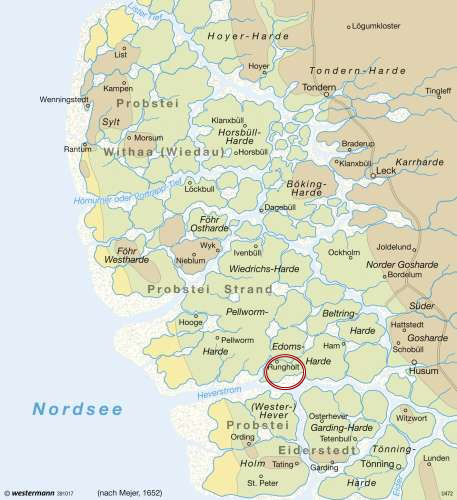
The North Frisian Coast with its islands, Halligen and the Wadden Sea before 1362 (x)
Now, in the course of time, several cities have sunk, so the question arises as to what made Rungholt so special that it was called the Atlantis of the North Sea. Rungholt mined peat and extracted salt, which they sold well. According to legend, Rungholt was incredibly rich, a large city in the middle of the mudflats. According to one legend, this made the people arrogant and thought they could go against God, whereupon he punished them with the flood. Another legend says that at a drinking party, it must have been around 1300, a few men, wild with wine, got a pig drunk. They put a nightcap on it and put it to bed. They laugh, they bawl, they call the priest to anoint the terminally ill man. The priest refuses. The men threaten him with beatings, drag him to the bed and pour beer over his hosts. Outraged by the desecration of the sacrament, the priest prays to God. Rungholt shall atone. The following night, a storm comes up. And while the lords of the town still stand on the dikes, blinded by their wealth, and think they can defy Blanken Hans (which is also the name given to the raging North Sea in a storm), the tide rises four cubits high over the tops of the dikes, swallows the town and everyone in it drowns. It is said to lie at the bottom of the sea to this day, pleading for salvation.

Dike breach, engraving by Johann Martin Winterstein from 1675 (x)
Unfortunately, there are hardly any records and none from that time, which makes Rungholt so legendary and even makes many people doubt that it really existed.
The first mentions date back to the 17th century and even these were initially questioned until a will was found in Hamburg. It dates from 1345 and has the full entry "Edomsharde, Kirchspiel Rungholt, Richter, Ratsleute, Geschworene, Thedo Bonisson samt Erben" (Edomsharde, Rungholt parish, judges, councillors, jury, Thedo Bonisson and heirs) as the addressee. To date, this is the only known document from the time before the town's demise. Obviously, Rungholt must have really existed and was even so large that it had its own church. The ethnologist and cultural historian Hans Peter Duerr even believes in a town the size of Hamburg, which had about 5,000 inhabitants at the time. He has evidence in the form of archaeological finds.
The first finds were made by fishermen in 1880, who found pottery shards, brick remains, large wooden remains and even plough marks from fields. Further finds were made in 1921 and 1940, where around 100 wells, the remains of about 28 terps, dike imprints and several supposed sluices were found, which later turned out to be sluices built by the inhabitants to drain the land.

Andreas Busch salvages beams of the so-called "Rungholtschleuse" (Rungholt sluice)1922 (x)
But is this really Rungholt or other towns that were also in the vicinity? There is a tendency to locate the town near the Hallig Südfall. But the Hallig has moved steadily eastwards over the centuries, and over time it has also migrated into the area of the vanished Rungholt. Today, therefore, it only reveals traces of a possible settlement at its north-western corner. But whether this is really Rungholt is questionable.

Storm tide,by Johannes Gehrs, 1880 (x)
This is still a matter of debate, but researchers have reconstructed the town as follows.
Rungholt was settled about a century and a half before the sinking. The houses, built of clay and grass sod, provided space for about 1000 inhabitants and stood on about 25 terps and on a dike about two metres high. Their livelihoods were based on livestock farming, seafaring, salt extraction from sea peat and trade. Around their settlement they cultivated grain, especially rye, on vaults.
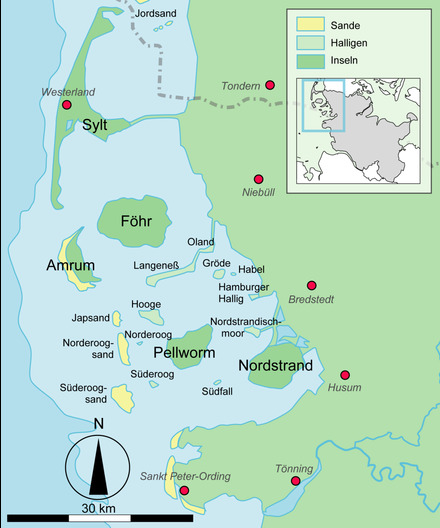
The region today (x)
The fact that Rungholt stood on a dyke, on which the mounds were located and the area was drained, made the land quite unstable. The Second Marcellus Flood was not a light storm, but lasted for three days. The dykes gave way bit by bit, the water swept everything away and undermined Rungholt's land, forcing it to sink. But it wasn't just Rungholt that was affected: more than 100,000 people are said to have died in the floods, lands sank and entire villages disappeared from the map almost without a trace. This fate struck 28, according to other sources at least 32, villages. Which clearly left its mark on the landscape.
51 notes
·
View notes
Text
Court Circular | 20th March 2023
Buckingham Palace
The King was represented by the Hon Dame Annabel Whitehead (former Lady-in-Waiting to The late Queen) at the Service of Thanksgiving for the Life of Lady Aird (former Lady-in-Waiting to The Princess Margaret, Countess of Snowdon) which was held in St Gregory’s Parish Church, Marnhull, Sturminster Newton, Dorset, this afternoon.
Kensington Palace
The Prince of Wales, Duke of Cornwall this morning received Mr Alastair Martin (Secretary of the Duchy of Cornwall) at Windsor Castle.
St James’s Palace
The Duke of Edinburgh this morning met groups of local volunteers at Farnham Riverside and planted a tree for The Queen’s Green Canopy, and was received by His Majesty’s Lord-Lieutenant of Surrey (Mr Michael More-Molyneux).
His Royal Highness, Patron, Mouse-Free Marion Project, this evening attended a Reception at South Africa House, Trafalgar Square, London WC2.
The Duchess of Edinburgh this afternoon received General Gwyn Jenkins (Vice Chief of the Defence Staff).
Her Royal Highness this evening attended a Reception for the Justice Ministers’ Conference at Lancaster House, Stable Yard, St James’s, London SW1.
St James’s Palace
The Princess Royal, Patron, Acid Survivors Trust International, today visited the Coronation Street Studio, ITV Studios, Trafford Wharf Road, Trafford Park, Stretford, and was received by Mrs Sharman Birtles (Vice Lord-Lieutenant of Greater Manchester).
Kensington Palace
The Duchess of Gloucester this morning attended the Volunteer Centre West Berkshire Knowledge Event at Shaw House, Church Road, Newbury, and was received by Mrs Sarah Scrope (Deputy Lieutenant of the Royal County of Berkshire).
Her Royal Highness, President, Royal Academy of Music, this afternoon attended a Meeting of the Governing Body at the Royal Academy of Music, Marylebone Road, London NW1.
#court circular#princess anne#princess royal#birgitte duchess of gloucester#prince william prince of wales#prince edward duke of edinburgh#sophie duchess of edinburgh#british royal family
11 notes
·
View notes
Photo
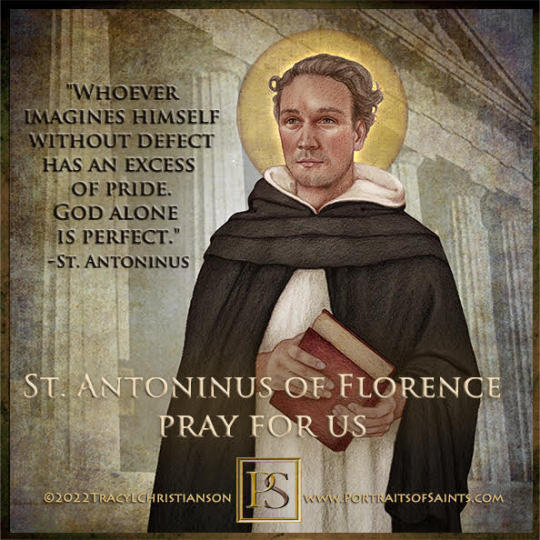
Saint Antoninus of Florence
1389-1459
Feast Day: May 2
Patronage: Moncalio, Turin, Italy, University of Santo Tomas Graduate School, Malia, Philippines, Pura Tarlac, Philippines, St. Antoninus Parish
Saint Antoninus was born to a noble family in Florence. He was a pious youth and a good friend of St. Dominic. At the young age of 16 he became a Dominican. Eventually he became the prior of St. Marks and reluctantly, Bishop of Florence. In this capacity, he was a reformer, theologian, confessor, and spiritual director and established a lay society known as “Good Men of St. Martin” which gave assistance to the poor. He died among his Dominican brothers on the feast of the Ascension.
Prints, plaques & holy cards available for purchase here: (website)
58 notes
·
View notes